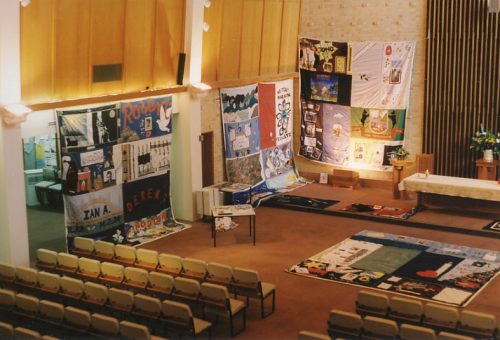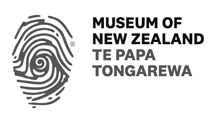Shane Austen Reid
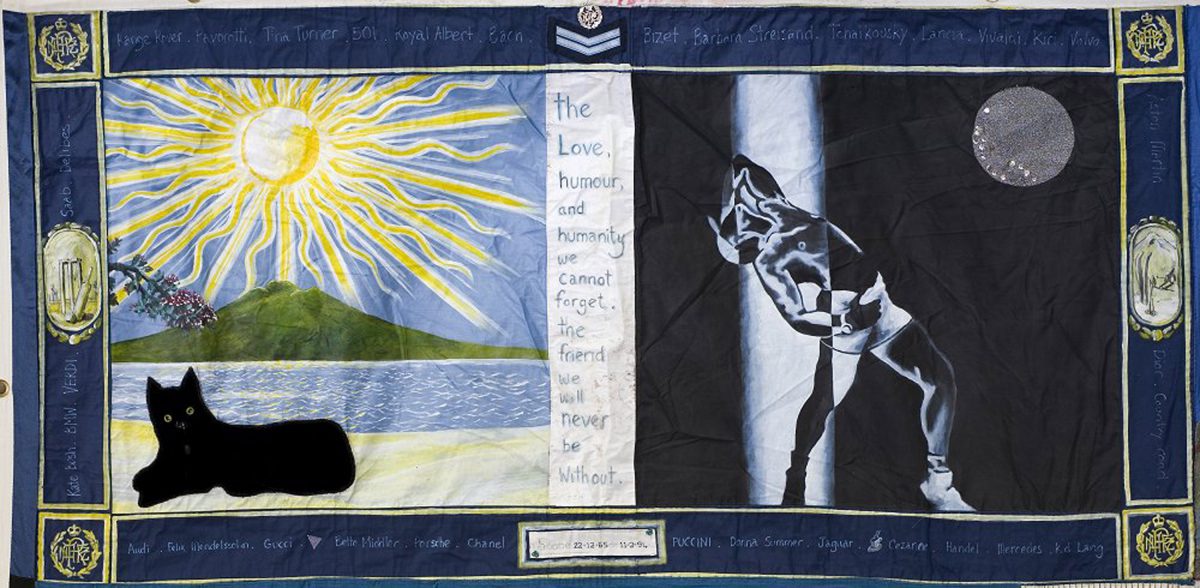
This panel was made with a lot of love and emotion by several of his close friends, his cousin Tania, and his mum. It helped us individually as well as helping one another to deal with our grief.
We wanted his panel to represent a picture of his life, so we divided it into two sections. The first one representing him as a lover of sunlight, his childhood and love of the beach and sea, his favourite Pohutukawa flower and tree (to represent his Maori heritage of which he was very proud and Christmas, his favourite time of year), and his cat, Mercedes.
The second half represents his love of dancing and night life. The ‘moon’ is also a mirror ball and Shane dances under its light. The figure/logo represents Shane’s favourite gay night club where he shared many fun times with friends dancing the night away. The cap was a standard item of attire for Shane.
The ‘day and night’ which also helps to illustrate that Shane had two lives he lived at the same time. Particularly whilst in the Air Force and coming to terms with his sexuality. In many ways his family life and friends were separate as well, for he was different things to different people.
Shane was a lover of style and quality things so first off our panel had to represent that or Shane would never forgive us. We surrounded the two sections with a frame, like a large picture frame as though it were a portrait reminiscent of the great portraits of ancestors hanging in the halls of the great houses of Europe which Shane would have adored. After all, our panel is a portrait of his life and our love. We filled it with all the things that he loved and were special to him.
We chose the two different blues to represent his Air Force career and put his Corporal stripes and hat badges at the top. At the four corners of the frame are the Air Force emblems, representing the four air bases Shane was stationed at. This all helps to emphasize important the Air Force was in shaping a large part of Shane’s life.
Around the border of the Quilt detailing represents things that Shane loved that were essential elements when thinking about him:
music – extremely important to him – his favourite composers, singers, performers
cars – a car fanatic – some of his favourite makes
activities – always a very active person – his love of cricket and skiing
labels – very fashion conscious – some of the designers he appreciated.
Shane was a proud New Zealander so we represented this by the Southern Cross.
The words down the centre of the panel are quoted from an excerpt of a death notice in the paper from one of Shane’s friends.
Shane’s name and date of birth and death are surrounded by gold stitching because of the golden person Shane was and our friendship was worth gold. The small pearl beads are there because of Shane’s taste for nice things. The sequins are from Amanda’s leotard as her small token.
Shane had so much life, energy, laughter and vitality. It is important that his panel is sewn together with the others, out there traveling about the country or indeed the planet, being seen and shared by so many people, young and old. Shane will never really be alone. He loved company always.
The one important ingredient that is essentially Shane is laughter. But how could you put that in a picture?
Shane was such a special person, who gave so much and took so little. He was everybody’s friend. How we miss him still.
Add a memory to this panel
If you wish to add your memories to this page, please get in touch.
Robert Payne

Robert loved the colour blue and it was no surprise that he asked us to make him a quilt with that wonderful deep rich colour of the sea and sky. Nature’s colour.
He also wanted the symbol of peace – the Dove. He was at peace when he died and his spirit is now free to fly on.
Three symbols of flora represent his three homes:
The Hibiscus is his childhood – Fiji (where he was born)
The Bush Wattyl is Australia and his chosen country
The Fern is New Zealand – his family and his final home (he died in Auckland)
These images are a true reflection of his passion for the wonder of nature. He loved tramping, he loved the mountains, he loved thunderstorms and the rain and the sea.
Robert lived to travel. The Mountains of Europe, Asia, Northern Africa, America, Australia and New Zealand are all sewn into his Quilt and his life. The little Morrie Van was a faithful steed.
A natural man, a lover of music and the arts, a realist, unquestionably honest and sincere. Our brother, our friend.
Made by his sisters Lucy, Janet and Margaret, and his dear friend Lois. November 1994.
Add a memory to this panel
If you wish to add your memories to this page, please get in touch.
Alastair Hall
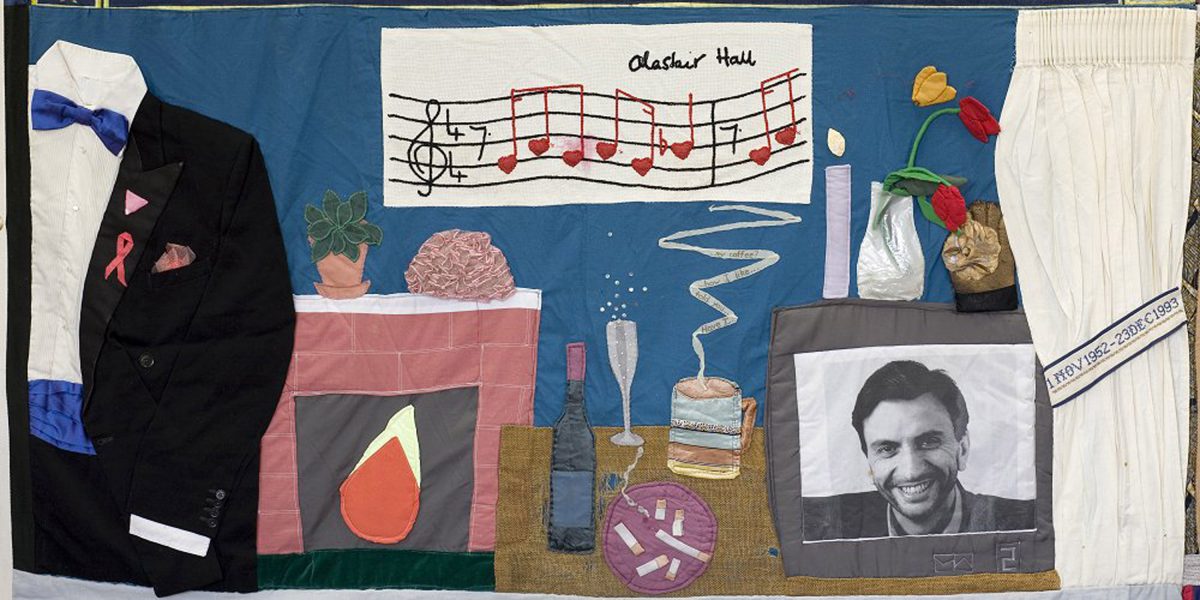
Alastair Hall Honoured as a Gay Hero.
A Christchurch gay man who has battled to bridge the gap between fear about AIDS and the reality has been honoured by a special award by the AIDS Foundation (now Burnett Foundation Aotearoa).
Christchurch Mayor Vicki Buck presented the award, a Terry Stringer bronze sculpture of an open hand, on Thursday, 25th November at the AIDS Foundation’s Ettie Rout Centre.
In a moving ceremony conducted before his family and friends, Alastair was praised for his extraordinary contribution to education about HIV and AIDS issues. Christchurch Central M.P. Ms Lianne Dalziel spoke of the important part Alastair has played in the success of the Human Rights legislation, and Ettie Rout Centre manager Dan Knowles described Alastair as a “genuine Canterbury hero”.
Mayor Buck also went on to say how important it is that support is not only given to those living with the AIDS virus but also to the caregivers “whose selfless work often goes unrecognised in our community”.
“While AIDS statistics are terrifying,” she said, “it’s vital to remember that those statistics are all unique individuals who need our support and understanding.”
The following is the text of a speech from New Zealand AIDS Foundation (now Burnett Foundation Aotearoa) Board Member, Tim Barnett:
Alistair, the New Zealand AIDS Foundation are presenting you with a special award in recognition of your extraordinary contribution to education about and mobilisation around HIV and AIDS.
Since you were diagnosed with HIV, you have shown thousands of New Zealanders how to bridge the distance between fear about AIDS and the reality of living with it. You have done this in four significant ways.
First, you have had the courage to talk to the media. Only eight years ago, gay men were labelled as criminals by New Zealand law. To speak out on matters related to sexuality, particularly matters involving sexuality and ill health, took immense bravery. You were one of the first people with HIV to talk openly about your HIV status and explain exactly what it is really like to live with HIV and AIDS. Thanks to you, and to others inspired by you, people have listened and they have understood.
Second, you have been to the heart of our nation, driven by your urge to educate and to explain. In prisons; schools and hospitals; in corporate boardrooms; on marae; in the Beehive [Parliament Buildings]; on the National Council on AIDS. You battled until the message was heard and understood. You have made a tremendous impact on the way in which AIDS and HIV are regarded in New Zealand today.
Third, you have immensely strengthened the ability of our community to deal with AIDS. You have served the AIDS Foundation as a representative of People with AIDS. You set up the first national Body Positive Peer Support Group and helped to set up the National People Living With AIDS Union.
Fourth, you have kept battling. Your life continues to inspire us. You are a survivor. You have shown the medical experts that sheer willpower can overcome immense barriers. Your friends have been inspired by your example, and operate a round-the-clock roster to support you.
Alistair, you have done more than we can express to counter fear, myth and prejudice on the basis of sexuality and of health status.
Thank you, on behalf of the AIDS Foundation and behalf of the people of New Zealand.
Alastair died four weeks after being presented with this award which is depicted on his Quilt by the gold coloured hand above his photo on the right-hand side of the Quilt.
Add a memory to this panel
If you wish to add your memories to this page, please get in touch.
Mana Frank Patrick
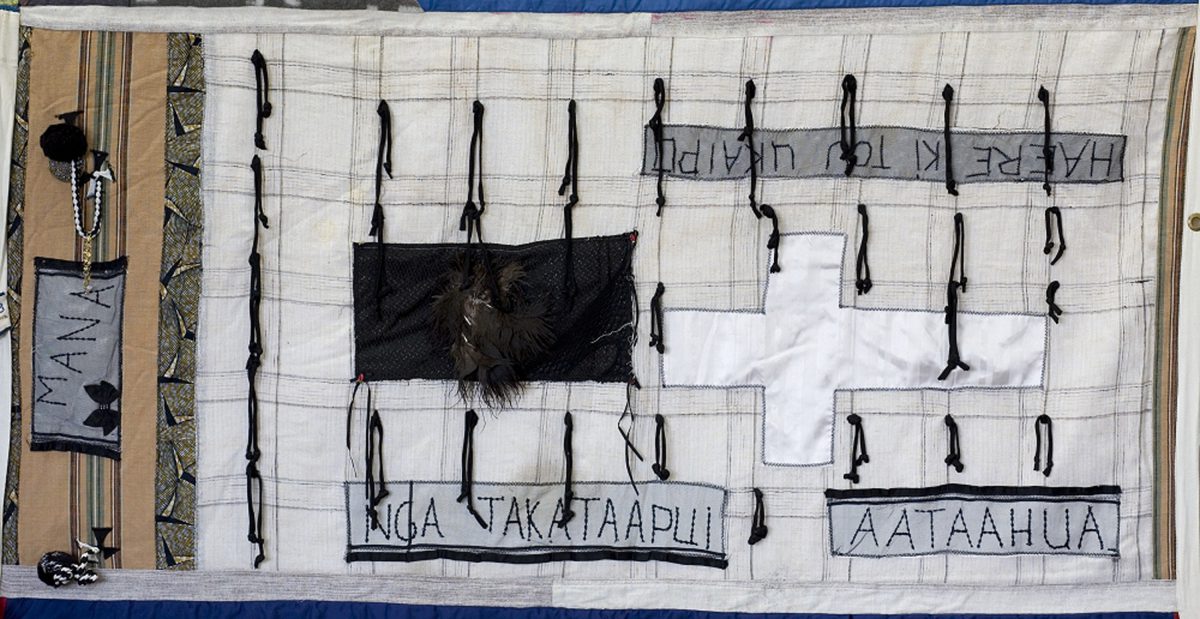
Mana Frank Patrick
Bianca
In memory of Mana Patrick and the mana of all Maori takataapui.
“Nga takataapui” means close companions of the same sex.
“Haere ki tau u kaipo” means go to the bosom of your mother.
“Aataahua” is beautiful.
The base of this cloak design was given to Mana by the “HERO” workshop, Middleton Rd, Newmarket. All taonga were used at HERO parties 1993 and 1994.
Mana passed away 10th of May 1994.
Add a memory to this panel
If you wish to add your memories to this page, please get in touch.
Ian A
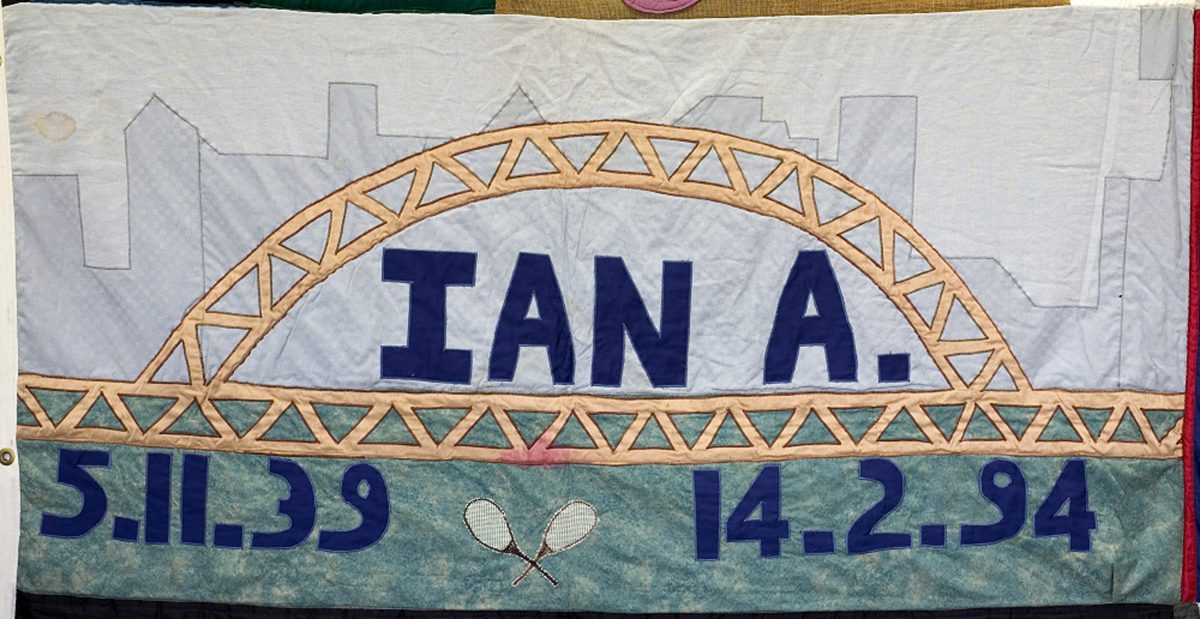
How does one pay tribute to a loyal and deeply respected friend? Ian was always very loyal and committed to whatever he did. And the most important of those commitments was to his family and friends. His very sincere, honest and caring qualities gained the respect and love of those immediately around him. His intelligence and a keen sense of humour made him great company to be with. His loyalty in friendships was absolute. What he expected from others he gave back in full measure.
He developed some deep interests during his lifetime and some of these are reflected in his Quilt. He was a very talented engineer and contributed in some very visible ways throughout New Zealand. He had a deep interest in architecture and appreciated the relationships between form and function.
He was a talented sportsman and continued to play until a few weeks before his death. He was a meticulous planner and paid great attention to detail. He liked to be in control and to be reliable. He felt friendships were most important in his life.
The Quilt has another very important significance. It is the only tangible recognition of the reason for his death. It is so important that we work to prevent suffering due to ignorance and prejudice.
In memory of a very loyal and much-missed friend.
Another person who helped make this panel notes:
The bridge and the cityscape which formed the background, represent the fact that Ian was a very talented engineer.
His surname was not included in deference to his family and others who were unable themselves to deal with the fact that his death was AIDS-related or who did not perhaps know that Ian was gay (he was not “out of the closet”).
The crossed tennis racquets are there to show his love for the sport.
Add a memory to this panel
If you wish to add your memories to this page, please get in touch.
Derek S
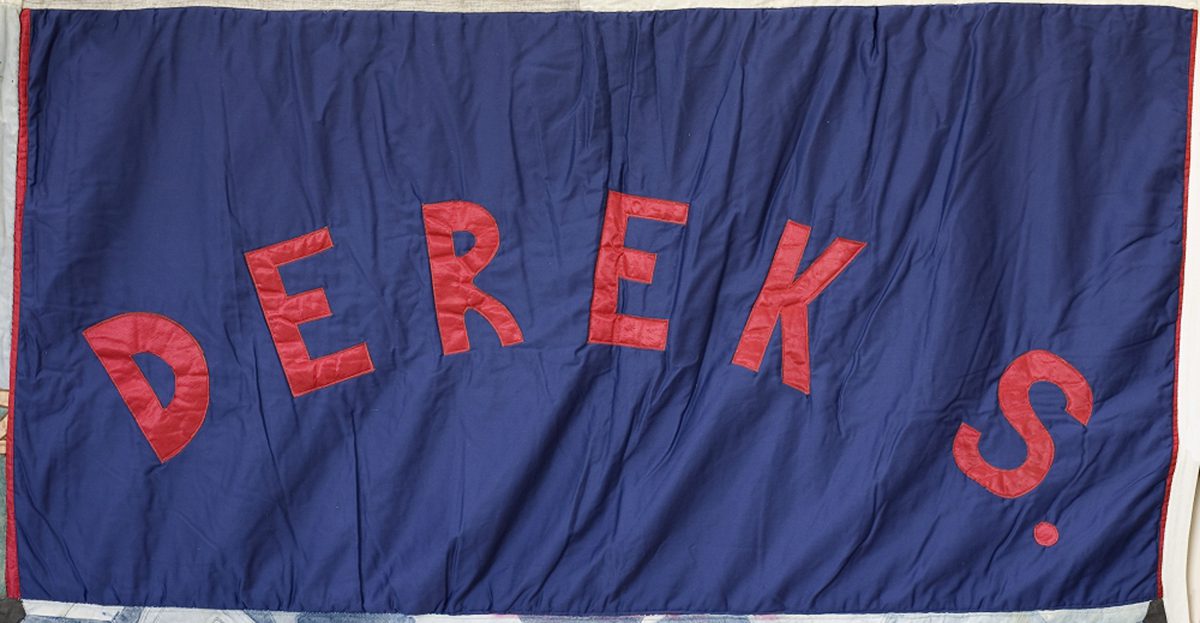
Due to the need for confidentiality and anonymity, there is no story to accompany this panel.
Add a memory to this panel
If you wish to add your memories to this page, please get in touch.
Howard

Sadly, at the time of setting up this website, we have no information about this panel
Add a memory to this panel
If you wish to add your memories to this page, please get in touch.
Rodger Wright
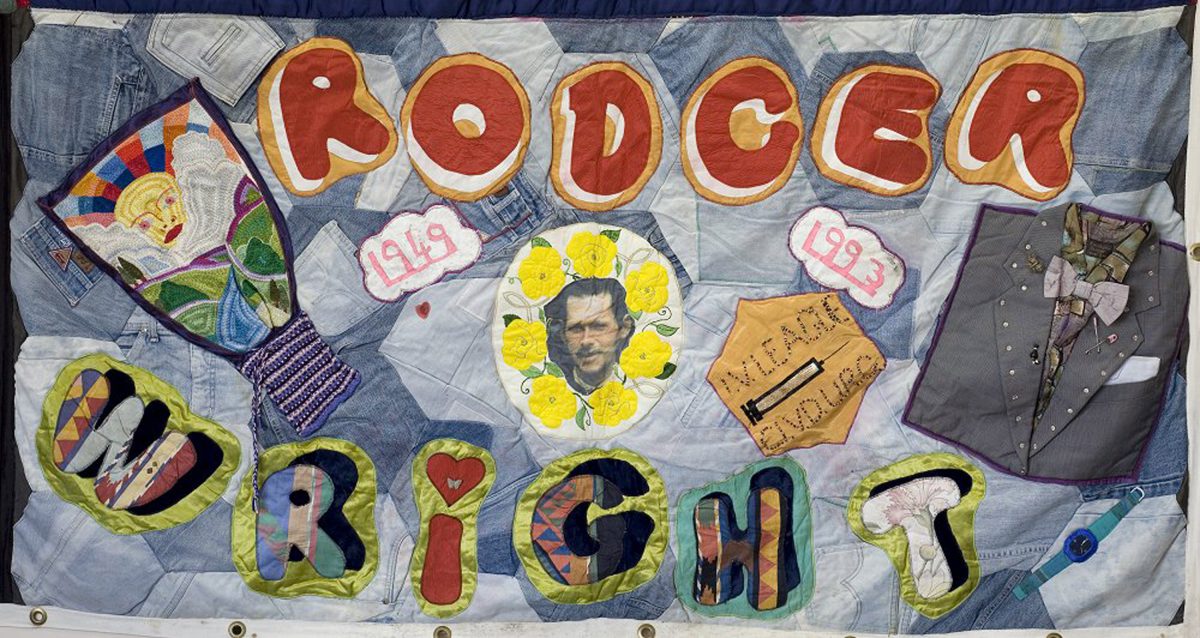
Rodger’s Quilt panel features his photo framed by yellow roses, a piece of embroidery done by Rodger, the front lapels of one of his jackets and IV League work. The Quilt background is a denim patchwork made by Rodger from his old jeans.
Most of us came to know Rodger because of HIV and AIDS. Rodger had a long association with this virus, and once it was confirmed that he, in fact, had the virus he committed himself to tell everybody all about it. He, in fact, said, “I’ll talk to anyone, any group, any organisation because the more it’s discussed the better, and the sooner we’ll have effective prevention programmes.”
So, imbued with his new found community spirit and his friendly disposition, and his outrageous coloured socks and matching bow-tie and colour co-ordinated watch, he embarked on what he called his ‘mission in death’ – to shake NZers out of their complacency, to shock them into recognition that AIDS is here not just in Sydney. He said that, for the first time in his life, he had direction and purpose – “something to fight for.”
He spent most days on some sort of educational work. He was keen to visit any secondary school happy for him to work on their health syllabus on AIDS education. And they were happy to invite him in. And so for many hundreds, possibly thousands, of Canterbury college kids, Rodger was the human face of AIDS.
They loved him because he pulled no punches, he spoke their language. He was honest and up-front, sometimes crude and just a little rude, but above all he showed a passionate concern for those kids he saw as being in danger of being infected.
Rodger’s decision to publicly own AIDS, to draw back the curtains on the most intimate and painful details of his battle with HIV, took enormous courage and conviction. At times it brought him something akin to celebrity status; with his endless speaking engagements, his appearances on radio talkback shows, and as the subject of what seemed to be regular newspaper and magazine articles.
At other times, he bemoaned the crippling isolation as he endured a succession of public, yet lonely illnesses. But he said, “the only thing I don’t need is sympathy…I’ve got over feeling sorry for myself.”
Rodger worked as an organiser and South Island Co-ordinator for the IV League, a voluntary group formed in 1985 in response to the growing AIDS epidemic among intravenous drug users around the world. (The centre in Christchurch is now known as The Rodger Wright Centre).
He was a foundation member of the National Council on AIDS in 1988. He had been appointed to represent the Injecting Drug Using community and remained on the Council until 1990.
Convinced that by stopping the spread of HIV amongst IVD (intravenous drug) Users an epidemic would be prevented among the general community, Rodger worked to convince our lawmakers that sharing needles happened because they were in short supply – not because of some sort of druggy psycho-social ritual.
He had considerable input into the Misuse of Drugs Act which came into effect on February 1, 1988 and which made it legal for participating pharmacists and others to sell special packs of needles and syringes to IVD Users and to exchange such packs for used needles. (Commonly called “The Needle Exchange Programme”). As well as containing information on where to obtain treatment for dependence, these packs had information on HIV, together with a condom, linking safe practices in sex and drug use.
Also during this time, the National Council wrote a major policy document for the government: The New Zealand Strategy on HIV/AIDS. Rodger’s contribution is said to have been useful and significant. Those involved are said to have admired Rodger’s ‘great patience and tolerance for those who had a lesser knowledge than he.” Alongside Gary McGrath, Rodger can be described as ‘an architect of New Zealand’s needle exchange programme.’
Rodger was a dedicated teacher who put the needs of others before his own.
Through Rodger we have learned that the virus can teach us to be more caring and supportive of each other.
Add a memory to this panel
If you wish to add your memories to this page, please get in touch.
Other photos of this block
Panels in this Block
| Panel Name | Life Years | Panel Link |
|---|---|---|
| Alastair Hall | 1 November 1952 - 23 December 1993 | View Panel › |
| Derek S | View Panel › | |
| Howard | 1960 - 1992 | View Panel › |
| Ian A | 5 November 1939 - 14 February 1994 | View Panel › |
| Mana Frank Patrick | died 10 May 1994 | View Panel › |
| Robert Payne | 9 December 1950 - 22 February 1994 | View Panel › |
| Rodger Wright | 1949 - 1993 | View Panel › |
| Shane Austen Reid | 22 December 1965 - 11 February 1994 | View Panel › |
